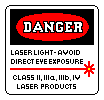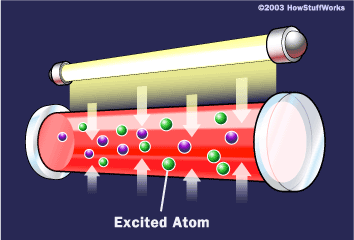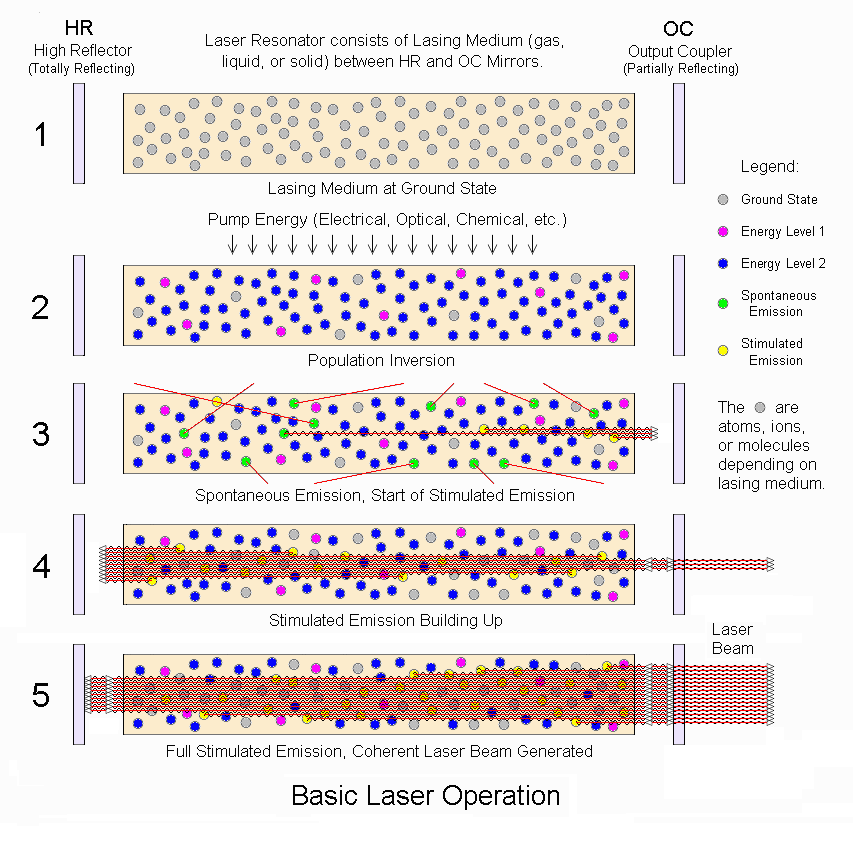Celebrations by Design


“Laser” is an acronym for Light Amplification by Stimulated Emission of Radiation. Laser light is emitted as a result of a chain reaction in which light striking electrons causes them to jump to higher energy levels and then release light of their own that is the same wavelength, phase and direction as the light that struck it. Laser light is different from light from a light bulb because it is monochromatic, in phase and unidirectional. The light is emitted by a lasing medium which is housed in a tube with a mirror at one end and a partial mirror at the other to allow the beam to pass through. The lasing medium is usually excited or “pumped” by a light source such as flash tube or by an electrical current. That energy causes the electrons to move up in energy and then back down, releasing light. There are several slightly different types of lasers based on the lasing medium they employ. When a lasing medium is pumped it undergoes a population inversion, that is; the atoms in the medium are excited and can remain so until stimulated (by a photon) to drop in energy level. For the case of Hydrogen a red wave (656.3nm) would be created when the electron falls from the third to the second energy level.

| Solid State Lasers: | such as ruby or yttrium-aluminum garnet use a solid medium and often emit light in the infrared spectrum, usually light pumped. |
| Gas Lasers: | often use Helium Neon or CO2. CO2 Lasers are often used for surgeries or cutting metals. |
| Excimer Lasers: | Use a noble gas and a halogen which bond when excited then subsequently decay and release their bond energy. The decay of this “pseudo-molecule” can be stimulated by light, creating amplification. These lasers emit in the infrared spectrum. |
| Dye Lasers: | Often use an organic pigment in solution and can be tuned to emit a spectrum of wavelengths. |
| Semiconductor Lasers: | Us electric current and metal compounds to create the beam and can come in a variety of wavelengths and range in power from mW to several watts. Many laser pointers are diode lasers. |
Lasers
can vary greatly in the amount of light they produce. For example, most
laser pointers have an output of less than 5mW, conversely, the Air Force is
working on a "air-borne" laser that is several kW. Lasers have a huge
variety of uses; from pointing at a projector screen, to surgeries, to shooting
down missiles, measuring distances and time, or just looking cool (the picture
below). 
Below is a more detailed picture of the chain reaction involved in a Laser, showing population inversion and spontaneous emission leading to more stimulated emission

For our shows we use four
![]() Sputnik
automated lasers. They have a variable out put from 100-1000nW and a
variable frequency from 633nm to 440nm
Sputnik
automated lasers. They have a variable out put from 100-1000nW and a
variable frequency from 633nm to 440nm
Sources:
http://theory.uwinnipeg.ca/mod_tech/node151.html
info.tuwien.ac.at/islt/safety/misc/ba_2_2.htm
http://vcs.abdn.ac.uk/ENGINEERING/lasers.html
http://science.howstuffworks.com/laser.htm
This page is not that of a real company but is for a chemistry assignment at Monmouth College.